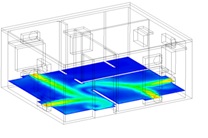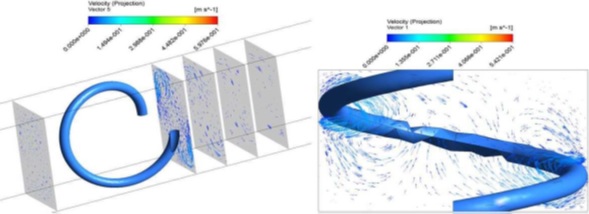Computational Fluid Dynamics (CFD)
Faculty Coordinator:
Dr. K. Obula Reddy
Associate Professor
Mechanical Engineering
Mobile: 9640853603
Email: obulareddy.k@bvrit.ac.in
What is Computational fluid dynamics?
Computational fluid dynamics (CFD) is a branch of fluid mechanics that solves and analyses issues involving fluid flows using numerical techniques and algorithms. The computations necessary to model the interaction of liquids and gases with surfaces specified by boundary conditions are performed on computers. Better solutions are possible with high-speed supercomputers. Current research is yielding software that increases the accuracy and speed of difficult simulation situations like transonic or turbulent flows. The first experimental validation of such software is carried out in a wind tunnel, with full-scale testing, such as flight tests, providing the ultimate validation.
Experiments vs. Simulations
CFD provides insight into flow patterns that are difficult, costly, or impossible to investigate using conventional (experimental) methods.
| Experiments | Simulations (CFD-Numerical) |
Quantitative description of flow phenomena using measurements • for one quantity at a time • at a limited number of points and time instants • for a laboratory-scale model • for a limited range of problems and operating conditions Error sources: measurement errors, flow disturbances by the probes • expensive • slow • sequential • single-purpose | Quantitative prediction of flow phenomena using CFD software • for all desired quantities • with high resolution in space and time • for the actual flow domain • for virtually any problem and realistic operating conditions Error sources: modeling, discretization, iteration, implementation • cheap(er) • fast(er) • parallel • multiple-purpose |
In most cases, CFD does not totally replace measurements, but it may greatly minimize the quantity of testing and overall expense. Transporting equipment and workers is tough. CFD software is lightweight, simple to use, and modify.
CFD – how it works
A mathematical model of a physical issue is used to start the analysis process.
- Matter, momentum, and energy conservation must all be met across the study area.
- Fluid characteristics are experimentally modeled.
- In order to make the issue tractable, simplifying assumptions are made (e.g., steady-state, incompressible, inviscid, two-dimensional).
- Set the problem’s beginning and boundary conditions appropriately.
- In the fluid area of interest, CFD uses numerical techniques (called discretization) to construct approximations of the governing equations of fluid mechanics.
- Algebraic control of differential equations.
- The grid refers to the collection of cells.
- For the flow field variables at each node or cell, a set of algebraic equations is solved numerically (on a computer).
- To produce a solution, a system of equations is solved concurrently.
- Quantities of interest are extracted from the solution after it has been post-processed (e.g. lift, drag, torque, heat transfer, separation, pressure loss, etc.)
This CFD lab is equipped with a high-end configuration system and academic licensed Research version ANSYS Workbench 19.1.
Currently, the following projects are ongoing with research-licensed software:
- Ventilation effect on Energy-efficient buildings – DST Project, BVRIT Narsapur. (Outcome: Two SCI papers published in the OXFORD University journal with IF-5.86)

- Numerical investigation of Hypersonic combustors (Outcome: 4 SCI publications with IF-5.81)

- CFD Analysis of Ceramic Kiln Design for energy efficiency
- Battery Thermal Management system for efficient design of battery pack with the desired cooling system.
- Numerical analysis of heat transfer enhancement studies using Nanofluids.











